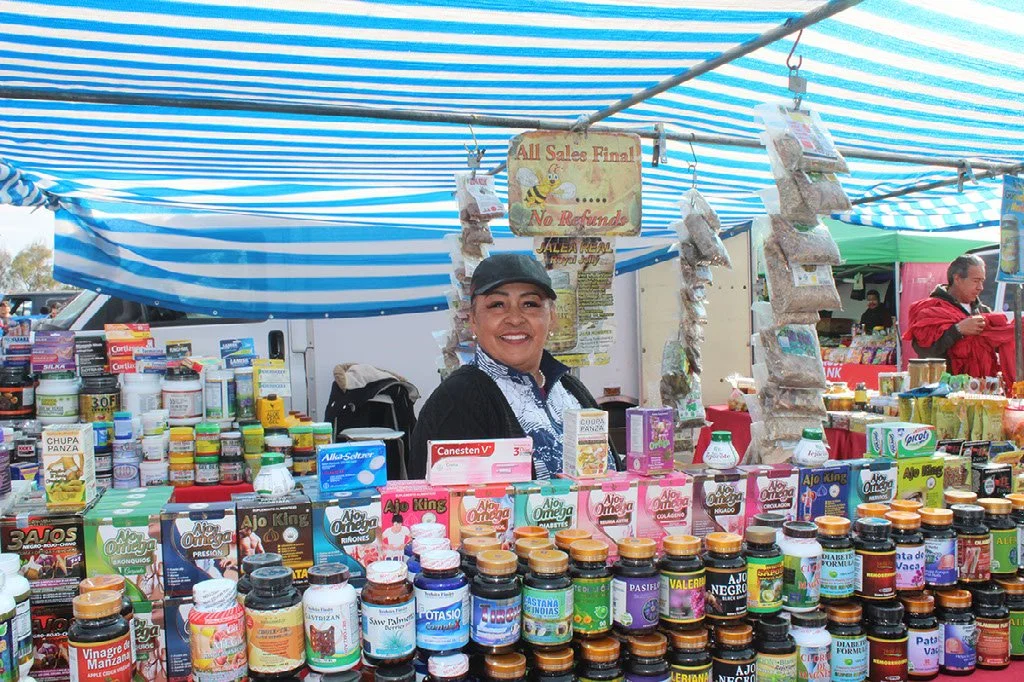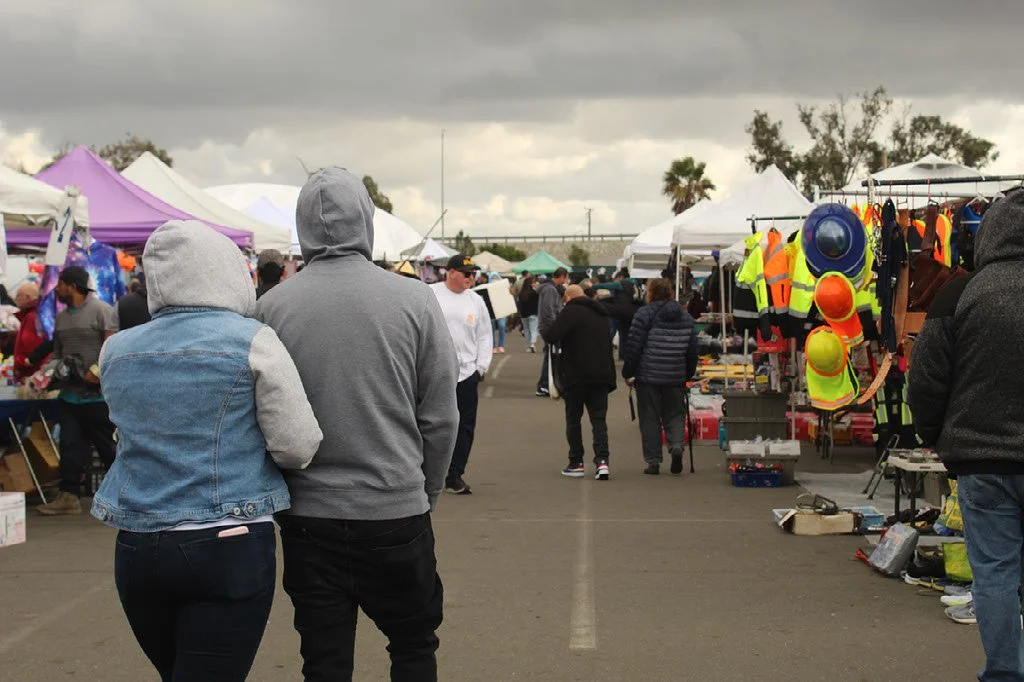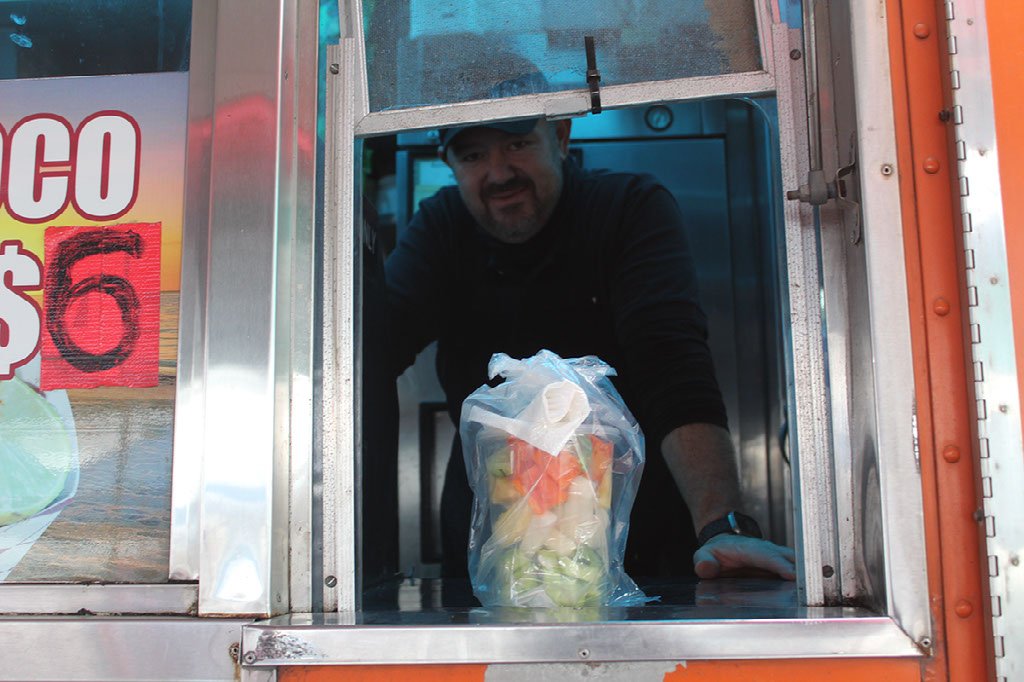Visual Journalism
Photo Essay — Alpine Village Swap Meet Vendors and Patrons Prepare for Permanent Closing
Prior to this project, my only memory of so much as touching a DSLR camera was when my cousin asked me to make sure “these pictures were okay” when we attended a waterpolo game as senior class historians in high school. I borrowed that same DSLR to take the photos featured in my essay. To create these photo essays, my visual journalism professor called on us to implement various photography techniques and select five to seven photos around which we constructed a story. I had caught wind of the impending shutdown of the Alpine Village Swap Meet, a flea market my family and I had attended on a nearly weekly basis for as long as I could remember and immediately knew that it was a story worth telling.
I went to the swap meet on an overcast Sunday morning, when it tends to be its busiest. I sought out to interview three vendors that would best showcase the diversity of products. I had the pleasure of speaking to Maricela Mora, who sells vitamins and natural medicines; Luis Ochoa, a food vendor known for his raspados and Tostilocos; and Nancy Luque, seller of all things hygiene and personal care. These three interviews were among the best ones of my college career; I appreciated their willingness to communicate their vulnerability, as all of them mentioned the uncertainty surrounding the future of their businesses. My interview with Mora was the first I had conducted in Spanish, but as a native speaker, I felt just as comfortable as I would have speaking English.
The Alpine Village Swap Meet had faced rumors of a shutdown on multiple occasions, so it was likely that patrons and vendors thought that this was one they could beat. As of Feb. 23, 2023, the Alpine Village Swap Meet is no longer in operation. Some vendors have moved to the Los Angeles Harbor City College and Long Beach City College Swap Meets. Following the completion of my project, I attended a vendor meeting at Long Beach City College and briefly remained in contact with Mora. Through this photo essay, I had fallen in love with journalism all over again; I was telling a story that mattered, lending a voice to a community with which I identify, establishing connections and discovering a love for photography. This was my first experience with visual journalism and I learned that my words will not always be the most powerful element of my storytelling, but rather, my photos and interviewees will speak volumes on their own.
Explainer Video — The “Ghost Runner” Rule’s Tangible Effect on MLB
As a diehard Dodgers fan, I will take advantage of any opportunity to talk about baseball. Naturally, when my visual journalism professor asked for a one-minute explainer video on a topic of my choosing, I landed on the permanent implementation of the MLB’s “ghost runner” — or automatic runner on second base in extra innings — rule. However, because all footage had to be original, I could not feature clips of the rule in action in past games. Instead, I filmed the exteriors of Dodger Stadium and Angel Stadium and created stop motion videos of baseball cards and white board animations.
As for my interviews, I decided to take an expert approach. I interviewed Peter Abraham, a longtime Boston Red Sox columnist for The Boston Globe, and Rick Burton, a sports management professor at Syracuse University — who both contributed numerous gems of insight, many of which I was unable to include due to the time restriction. I asked each of them how this rule has revolutionized baseball, a sport that once prided itself on tradition and the unchanging — a relevant question considering the introduction of additional rules such as the pitcher’s clock and banning of the defensive shift.
This was my first time trying my hand at video editing, as well as my first experience with Adobe Premiere. I spent a couple of sleepless nights binging Premiere tutorials on YouTube and scouring the internet in an attempt to teach myself something as simple as including a circle animation to draw attention to earned run average and on base percentage statistics.
Among my central goals was to make this video as engaging as possible for those who are looking to get into baseball with no prior experience with the sport. One of the first people I sent my final draft to was my childhood best friend, who gives me her password for MLB TV provided to her for free thanks to her T-Mobile plan, since she “will never use it herself.” When she said understood the gist of the rule, I decided I had done a decent job. Through this project, I learned the importance of quote selection from interviews, the versatility of video editing and storytelling through mediums other than print.
Social Video — The Vitality of LGBTQ+ Literature in Public Schools and Libraries
I finished off my visual journalism course with a two to three minute social media video that covered a topic related to adversity. After three different story pitches, more emails than I can remember sending and one too many voicemails, I found my story in recent American book bans and a local controversy regarding LGBTQ+ literature in Palos Verdes. The reading of Kyle Lukoff’s “Too Bright to See” by two fifth grade teachers to their students was discussed at a March 8, 2023, Palos Verdes Peninsula Unified School District Board of Education meeting. The book features a transgender male protagonist, prompting both advocates and protestors to share their views during public comment.
As with any story, I understood the crucial nature of including both perspectives — so I was excited to secure interviews with a founder of Save PV Schools, a parent advocacy group, and the co-presidents of PV High School’s Gay-Straight Alliance. To gain insight on the public library level, I contacted libraries in Llano County — where 12 titles were recently pulled and then returned to shelves — New York City, Boston, Los Angeles, Lomita, Torrance and Palos Verdes. A Torrance librarian and Palos Verdes children’s collection manager were kind enough to meet with me and discuss their respective collection development policies, which explain book selection and criteria. Their voices were fundamental to the video.
I found this project to be the most difficult given its topic’s controversial nature, as select interview prospects were either unable to provide comment at this time or said they were unable to contribute substantial information. The people who did allow me to interview them, however, appeared to have felt strongly about their stances. For this project, my interviews are what I am most proud of. I was tasked with featuring commentary from opposing sides in a manner that seemed neither combative nor conciliatory — a challenge in itself, but one that I now feel confident to face again.
Reporter Package — Former Alpine Village swap meet vendors struggling months after shutdown
For the second class in Annenberg’s reporting series, the sole demand for our final pitches was that we select a story exhibiting adversity. I returned to a story I’d covered in my visual journalism course — that of the Alpine Village Swap Meet vendors. This reporter package was a follow-up, a “Where Are They Now?” type of segment going behind the scenes of their evictions, and explaining how they’ve recovered — or struggled to — since then. Accompanying the package is an original reporter’s script and article. I managed to visit the Swap Meet’s original site — before it was fenced off — and track down some vendors, as well as attend a meeting between them at a prospective vending site.
I interviewed three vendors who had relocated to Harbor City College Swap Meet, one who operates out of multiple locations throughout the week, and an Economic and Community Development Assistant Deputy operating under Los Angeles County Board of Supervisors member Holly Mitchell. I gained further insight as to why the Swap Meet was shut down, and the notification and warning efforts the City had gone through to communicate its closure to vendors.
Vendors mourned the sense of community they had founded at the Alpine Village Swap Meet and expressed the trials and tribulations of their relocation efforts, one of them opening up to me about the decline in their mental health as they struggled to cope with a loss of stable income. But, as that vendor said, “Like good Mexicans, we persevered.”
This was my first ever reporter package, and though I find myself to be more comfortable behind the camera, it gave me a greater sense of appreciation for on-air reporters. My reporter standup was entirely ad-libbed as I stood in front of the Swap Meet’s original site on a busy street just feet away from a freeway entrance, enduring multiple takes as cars made note of my camera set-up, honking at me as they passed by.


